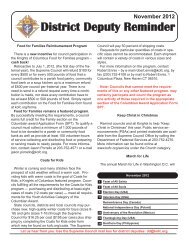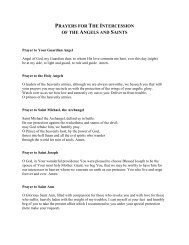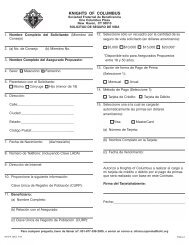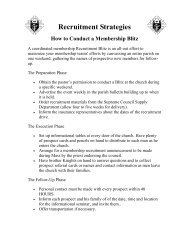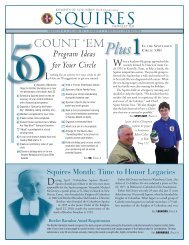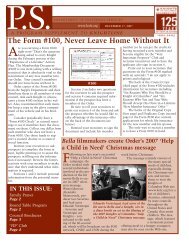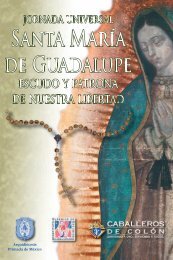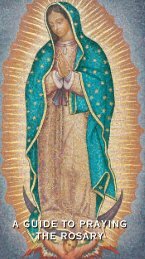Revelation: - Knights of Columbus, Supreme Council
Revelation: - Knights of Columbus, Supreme Council
Revelation: - Knights of Columbus, Supreme Council
Create successful ePaper yourself
Turn your PDF publications into a flip-book with our unique Google optimized e-Paper software.
II<br />
WHAT JOHN SAW<br />
In taking up the question <strong>of</strong> the symbolism <strong>of</strong> the Apocalypse, we should<br />
make one thing plain from the beginning, and that is that we do not intend<br />
to question for one minute the reality <strong>of</strong> John’s vision. John is a prophet; he<br />
has an authentic message from God. The teaching <strong>of</strong> the Apo calypse is true<br />
and is a true record <strong>of</strong> revelation given to John.<br />
But the Apocalypse is a record <strong>of</strong> revelations received formerly and written<br />
down only later (1:9ff.). Probably John received these rev elations over a<br />
considerable period <strong>of</strong> time. Their organization into book form, following an<br />
outline and set manners <strong>of</strong> expression, is the work <strong>of</strong> John himself acting<br />
under divine inspiration. The form <strong>of</strong> writing, which he employed, as was<br />
pointed out in the last article, was Jewish apocalyptic.<br />
He himself tells us as much. He says, for example, that he saw “one like a<br />
son <strong>of</strong> man” (1:13), that before the heavenly throne “there is as it were a sea <strong>of</strong><br />
glass, like crystal” (4:6), “I saw a Lamb standing, as though it had been slain”<br />
(5:6), “I saw what ap peared to be a sea <strong>of</strong> glass mingled with fire” (15:2), and so<br />
forth. If we add together all the “like’s,” the “as though’s,” and the “as it<br />
were’s” <strong>of</strong> the Apocalypse, we should find that they are one <strong>of</strong> its chief<br />
character istics. John has not said, in other words, that he saw with his bodily<br />
eyes a man, a sea <strong>of</strong> glass, or a slain Lamb, but things that can be symbolized<br />
by these representations. One commentator on the Apocalypse has said well<br />
that this book was not so much seen by its author as thought by him. The<br />
images which he has used, and which almost without exception he has<br />
borrowed from earlier literature, he has employed to give expression to his<br />
revealed thoughts.<br />
This is an important fact to keep in mind when reading the Apocalypse.<br />
Take, for instance, the pas sage in 5:6ff. John saw a Lamb standing, but as<br />
though slain. Just how does a slain lamb stand? In fact, this lamb does not act<br />
very slain at all, since “he went and took the scroll from the right hand <strong>of</strong> him<br />
who was seated on the throne” (v. 7). This lamb, too, has seven horns and seven<br />
eyes. What are we to make <strong>of</strong> all this? That John actually was given a picture<br />
- 15 -




